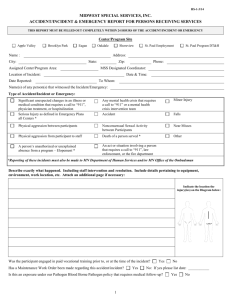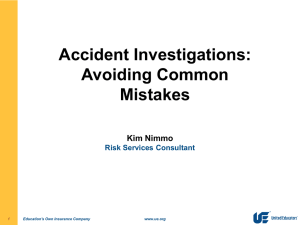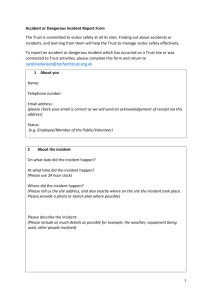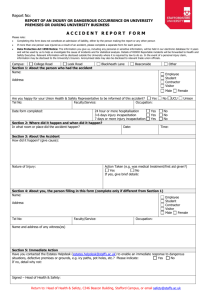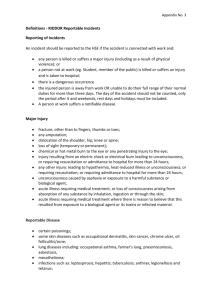guidance on completing the
advertisement
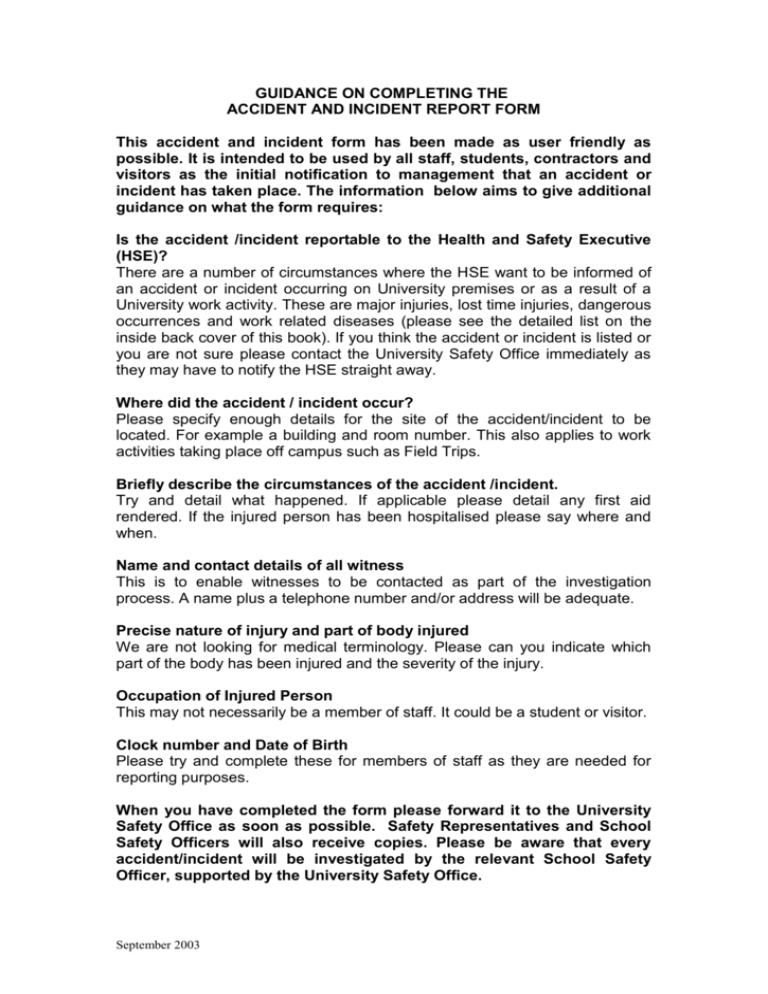
GUIDANCE ON COMPLETING THE ACCIDENT AND INCIDENT REPORT FORM This accident and incident form has been made as user friendly as possible. It is intended to be used by all staff, students, contractors and visitors as the initial notification to management that an accident or incident has taken place. The information below aims to give additional guidance on what the form requires: Is the accident /incident reportable to the Health and Safety Executive (HSE)? There are a number of circumstances where the HSE want to be informed of an accident or incident occurring on University premises or as a result of a University work activity. These are major injuries, lost time injuries, dangerous occurrences and work related diseases (please see the detailed list on the inside back cover of this book). If you think the accident or incident is listed or you are not sure please contact the University Safety Office immediately as they may have to notify the HSE straight away. Where did the accident / incident occur? Please specify enough details for the site of the accident/incident to be located. For example a building and room number. This also applies to work activities taking place off campus such as Field Trips. Briefly describe the circumstances of the accident /incident. Try and detail what happened. If applicable please detail any first aid rendered. If the injured person has been hospitalised please say where and when. Name and contact details of all witness This is to enable witnesses to be contacted as part of the investigation process. A name plus a telephone number and/or address will be adequate. Precise nature of injury and part of body injured We are not looking for medical terminology. Please can you indicate which part of the body has been injured and the severity of the injury. Occupation of Injured Person This may not necessarily be a member of staff. It could be a student or visitor. Clock number and Date of Birth Please try and complete these for members of staff as they are needed for reporting purposes. When you have completed the form please forward it to the University Safety Office as soon as possible. Safety Representatives and School Safety Officers will also receive copies. Please be aware that every accident/incident will be investigated by the relevant School Safety Officer, supported by the University Safety Office. September 2003 Major Injuries – Staff Only Fracture (but not to hands or feet) Amputation Dislocation of the shoulder, hip, knee or spine Loss of sight (temporary or permanent) Chemical or hot metal burn to the eye or any penetrating injury to the eye Injury resulting from an electrical shock or electrical burn leading to unconsciousness or requiring resuscitation, or requiring admittance to hospital for more than 24 hours. Any other illness leading to hypothermia, heat-induced illness or unconsciousness, or requiring resuscitation, or requiring admittance to hospital for more than 24 hours. Unconsciousness caused by asphyxia or exposure to harmful substances or biological agent. Acute illness requiring medical treatment, or loss of consciousness arising through absorption of any substance by inhalation, ingestion or through the skin. Acute illness requiring medical treatment where there is reason to believe that this resulted from exposure to a biological agent or its toxins or infected material. If a member of staff has been off more than 3 days as a result of an accident Students and Members of the Public Only Going direct from the premises to hospital as a result of an accident in connection with the condition of the premises. Dangerous Occurrences Collapse, overturning or failure of load bearing parts of lifts and lifting equipment. Explosion, collapse or bursting of any closed vessel or associated pipe work. Failure of any freight container in any of its load bearing parts Plant or equipment coming into contact with overhead power lines. Electrical short circuit or overloading causing fire or explosion. Any unintentional explosion, misfire, failure of demolition to cause the intended collapse, projection of material beyond a site boundary, injury caused by explosion. Accidental release of a biological agent likely to cause severe human illness. Failure of industrial radiography or irradiation equipment to de-energise or return to its safe position after the intended exposure period. Malfunction of breathing apparatus while in use or during testing immediately before use. Failure or endangering of diving equipment, the trapping of a diver, an explosion near a diver, or an uncontrolled ascent. Collapse or partial collapse of a scaffold over 5 metres high, or erected near water where there could be a risk of drowning after a fall. Diseases Poisonings by chemical Chromeulceration. Folicilitis, acne or skin cancer caused by mineral oil, pitch or arsenic Inflammation, ulceration or malignancy caused by ionising radiation Occupational asthma under certain conditions Pneumoconiosis under certain conditions Asbestos related lung diseases Leptosiprosis, hepatatis, TB or illness caused by occupational pathogen Cataract caused by exposure to radiation Decompression sickness Chemical induced cancer Vibration white finger September 2003


